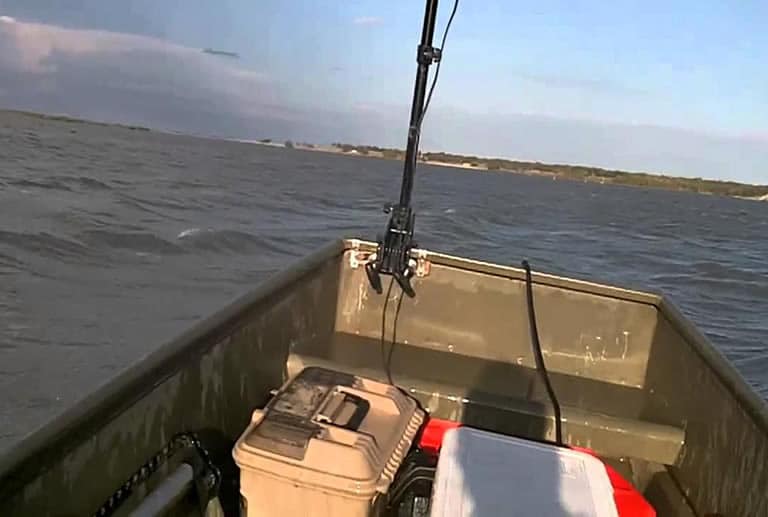Contents
The Uncomfortable Truth About Jon Boats In Rough Water
Can a Jon boat handle rough water safely?
Jon boats are designed for calm water. They are not designed to be used in rough water.
Only specific types of Jon boat can be used in rough water and only under certain conditions.
A standard Jon boat has a square bow, a flat bottom and a shallow draft that isn’t suited to rough water.
A semi-v (mod-v) Jon boat has a bow that is designed for cutting through choppy water. But the boat still has a flat bottom with all the same disadvantages in rough water as any other flat bottomed boat.
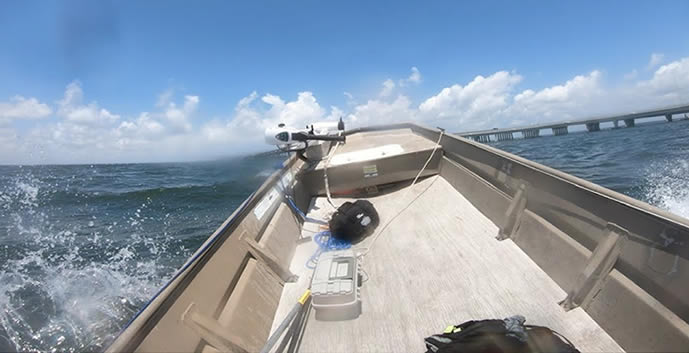
You can use a semi-v Jon boat in slightly rough water but only at slow speeds and they are not designed to be used in very challenging conditions where waves are over 5 feet.
Boats used in rough water have specific hull designs
Before we look at the design characteristics of a Jon boat to illustrate why it’s not good for rough water, it is a good idea to quickly look at the characteristics of a boat that is specifically designed to ride rough water.
By looking at the design characteristics of a rough-water-boat you will be able to see how the design differences in the hull of a Jon boat make it unsuitable for rough water usage.
The type of boat designed for deep water and rough water use has a v-hull.
This hull design lets the boat sit much deeper in the water (giving it a deep draft) which means it is much more stable when rocked by waves.
Fishing boats and yachts have a v-shaped hull and are therefore said to be v-hull boats with deep drafts.
They can ride large waves with ease.
On the flip side v-hull boats are not very well suited to inland waterways as they tend to have areas of very shallow water.
Because the boat sits deeper in the water it is likely to become grounded or get damaged if it is taken into these shallow areas.
Before I delve into the hull design of a Jon boat it is a good idea to give you a quick overview of how draft works on a boat.
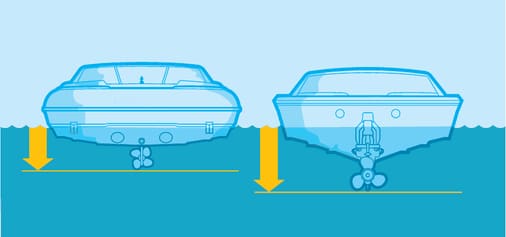
How shallow draft vs deep draft boats perform in rough water
As mentioned above a vessel designed to be used in deep waters like the ocean will have a deep draft. One that is designed to be used in shallow waters will have a shallow draft.
A shallow draft boat has a bottom that sits very close to the water surface.
This makes them very stable in calm conditions and very speedy when moved across calm waters because they experience much less resistance from the water.
Shallow draft vessels, like a Jon boat, are also capable of navigating areas of water that are extremely shallow.
Both a flat-bottomed Jon boat and a semi-v Jon boat have a shallow draft. This is because the deepest part of the boat is close to the water surface.
If you want to know more about shallow draft and deep draft read this article.
Because a deep draft boat sits deeper in the water it is more stable and less likely to flip in rough waves.
However, in calm water a deep draft boat can feel rocky or even “tippy”.
Because a shallow draft boat sits much closer to the water surface it is more unstable and more likely to take on water or capsize in rough waves.
However, because it “sits” on the water surface it is extremely stable in calm water.
Now you understand how draft works on a boat let’s look at how the draft on a Jon boat make sit unsuitable for rough water.
Why a Jon boat hull design is not suitable for rough water
Before we delve deeper into the topic of using a Jon boat in rough water I need to give you a basic understanding of the hull design of a Jon boat.
Understanding the basic hull design will show you why a Jon boat is best suited to calm marine environments and why it is unsuited to choppy water.
A Jon boat has a hull that differs greatly from the v-hull ocean-going, rough water, boats mentioned above.
A Jon boat is designed to be used in the type of shallow inland water areas where v-hull boats would struggle to access.
Although there are many variations of Jon boat available, and many different models on the market, we can view a Jon boat as belonging to one of two types only.
Both types are shallow draft boats.
The two basic types of Jon boat are:
- Flat bottomed Jon boat.
- Semi-v Jon boat.
Lets take a quick look at these two types of Jon to see how they differ from each other, why they differ from each other and how those differences relate to rough water usage.
For more information of different models and makes of Jon boat read this article.
The flat-bottomed hull of a Jon boat is unstable in rough water
A typical standard Jon boat will have a flat bottom.
Flat-bottomed Jon boats are designed to be used on inland waters that are fairly protected from strong winds i.e. calm inland waterways that don’t experience much wave activity.
A flat bottom Jon boat on calm water is extremely stable.
This is the opposite of a V-hull boat which will rock a lot on the same water.
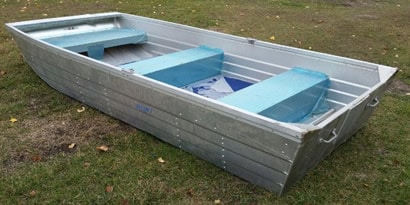
In addition to improved stability the flat bottom hull also gives a Jon boat a very shallow draft which means it can navigate waters that are only a few inches deep.
This makes it perfect for shallow water lakes, ponds, rivers and creeks etc.
It also makes it an excellent boat for inland-waterway utility work, transportation, duck hunting and shallow water fishing.
Unfortunately though, the flat bottom and shallow draft of a standard Jon boat means it becomes uncomfortable to ride in and unstable in choppy waters.
It becomes downright dangerous in large waves!
The semi-v Jon boat was created to combat some of these disadvantages but you should always keep in mind that it is still a flat bottom boat.
It therefore has all the same disadvantages of any other flat bottom boat and carries with it the same dangers when used in rough water.
A semi-v Jon boat hull gives a little extra rough water protection
Although a flat-bottomed Jon boat is very versatile it does not like choppy water or challenging weather conditions.
This is not ideal for some inland waterway boaters that need a shallow draft boat but who often have to deal with rapid changes in weather and water conditions.
For this reason the semi-v Jon boat was designed.
A semi-v Jon boat can be used in environments where a standard Jon boat is preferred over a v-hull boat.
But it is better than an standard Jon boat in areas that experience the type of frequent strong winds and choppy waters unsuited to a flat-bottomed vessel. This is because it’s curved and pointed bow allow the boat to cut through waves.
So how does a semi-v Jon boat achieve this “best of both worlds” approach to boating? Well it has to do with its hull design.
A semi-v Jon boat does not have a completely flat bottom like a standard Jon but neither does it have a full V-shape bottom (like a v-hull boat). It is a hybrid of the two.
A semi-v Jon boat has a shallow draft because its bottom still sits fairly close to the water surface but it is more curved and deeper than a flat-bottomed Jon.
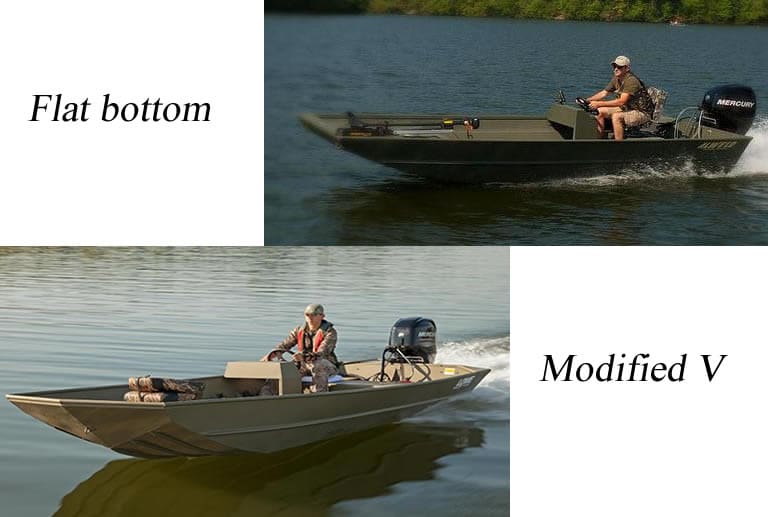
This gives it a slightly deeper draft and therefore more stability in choppy waters than a flat-bottomed Jon.
A semi-v Jon boat will be able to handle rough water much better than a flat-bottomed Jon boat while still being able to access fairly shallow waterways.
So, although it has a shallow draft and can traverse shallow waterways, a semi-v Jon has a bow that can better cut through choppy water.
It still has a flat bottom though and is just as susceptible to instability as a standard “flat bottom” Jon boat.
So, How Safe Is A Jon Boat In Rough Water?
We covered before the dangers involved in using a Jon boat in the ocean.
The same type of dangers exist if you use a Jon boat on inland waters that are very rough and challenging.
Can a Jon boat be used in rough water?
- A flat-bottomed Jon boat is not designed to be used in rough water.
- A semi-v Jon boat can handle rough water much better but it is still not designed to ride large waves.
The simple truth is that if you find yourself on a Jon boat and the weather starts to turn nasty you should get off the water as quickly and safely as you can.
A flat bottomed Jon boat should not be used in rough water.
A semi-v hull Jon boat can handle rough water a lot better but it still not designed to be used in challenging conditions.
Larger Jon boats will fair better in rough water than smaller ones.
However, if you want to navigate rough waters frequently you should consider getting a v-hull boat!
If getting a v-hull boat is not an option, due to the shallow nature of the waters you boat on, then you should opt for a semi-v Jon.
But be careful about staying out on the water when the conditions become challenging. A semi-v Jon boat is still a flat bottom vessel with all the same disadvantages of any other flat bottom boat.

